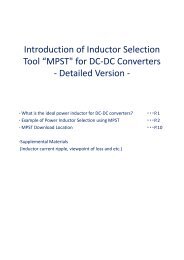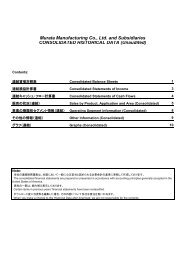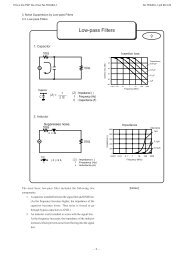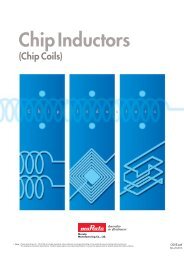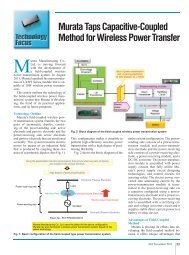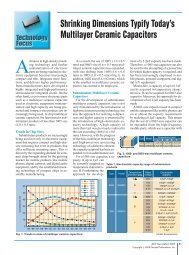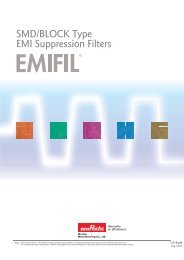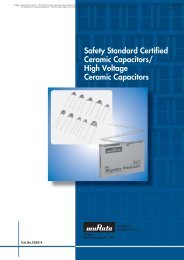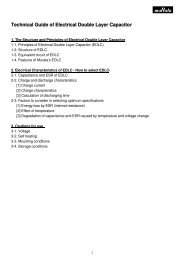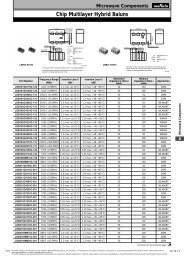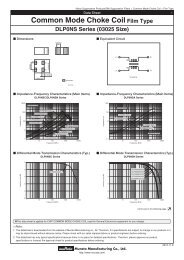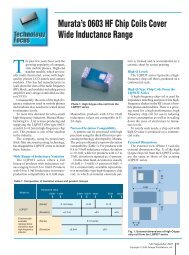PTC Thermistors POSISTOR ® for Circuit Protection - Murata
PTC Thermistors POSISTOR ® for Circuit Protection - Murata
PTC Thermistors POSISTOR ® for Circuit Protection - Murata
You also want an ePaper? Increase the reach of your titles
YUMPU automatically turns print PDFs into web optimized ePapers that Google loves.
!Note • Please read rating and !CAUTION (<strong>for</strong> storage, operating, rating, soldering, mounting and handling) in this catalog to prevent smoking and/or burning, etc.<br />
• This catalog has only typical specifications. There<strong>for</strong>e, please approve our product specifi cations or transact the approval sheet <strong>for</strong> product specifi cations be<strong>for</strong>e ordering.<br />
R90E.pdf<br />
Sep.24,2012<br />
Overheat Sensing Chip Type Specifications and Test Methods<br />
c PRF18/21_471Q Series<br />
No.<br />
Item<br />
Specification<br />
Test Condition<br />
1 Resistance Value (25°C)<br />
The resistance value shall be within the specified<br />
tolerance.<br />
After applying max. operating voltage <strong>for</strong> 3 minutes and<br />
leaving <strong>for</strong> 2 hours in 25°C, measured by applying voltage less<br />
than 1.5VDC. (by a direct current less than 10mA).<br />
EIAJ ET-7403 term 9<br />
Prepare soldered <strong>PTC</strong> to PCB (**)<br />
and add the <strong>for</strong>ce of 5.0N in the direction as shown below.<br />
(<strong>PTC</strong>=<strong>POSISTOR</strong>r)<br />
<strong>PTC</strong><br />
2 Adhesive Strength There is no sign of exfoliation on electrode.<br />
F<br />
F<br />
<br />
3 Vibration Resistance<br />
4 Solderability<br />
Normal appearance<br />
Resistance change: not to exceed ±20% (*)<br />
Min. 95% electrode is covered with new solder.<br />
Resistance change: not to exceed ±20% (*)<br />
JIS C 5102 term 8.2<br />
Soldered <strong>PTC</strong> to PCB (**)<br />
Vibration: 10-55-10Hz (1 min.)<br />
Width: 1.5mm<br />
Vibrate <strong>for</strong> 2 hours. in each of 3 mutually<br />
perpendicular plane <strong>for</strong> a total of 6 hours<br />
JIS C 60068-2-20(1996)<br />
Solder temp.: 230±5°C<br />
Solder: Sn63%/Pb37% (or 60%/40%)<br />
Soaking time: 3±0.5 seconds<br />
Soaking position: Until a whole electrode is soaked.<br />
5 Soldering Heat Resistance Resistance change: not to exceed ±20% (*)<br />
JIS C 60068-2-20 (1996)<br />
Solder temp.: 260±5°C<br />
Solder: Sn63%/Pb37% (or 60%/40%)<br />
Flux: containing less than 0.2wt% of chlorine<br />
Soaking time: 10±0.5 seconds<br />
Soaking position: Until a whole electrode is soaked.<br />
Preheating: 150±5°C, 3 minutes<br />
6 Dry Heat<br />
7 Cold<br />
8 Temperature Cycling<br />
Normal appearance<br />
Resistance change: not to exceed ±20% (*)<br />
Soldered <strong>PTC</strong> to PCB. (**)<br />
150±2°C leave <strong>for</strong> 1000±12 hours<br />
Soldered <strong>PTC</strong> to PCB. (**)<br />
-20±3°C leave <strong>for</strong> 1000±12 hours<br />
JIS C 5102 term 9.3<br />
Soldered <strong>PTC</strong> to PCB. (**)<br />
Times: 5 cycles<br />
Step Temp. (°C)<br />
1<br />
2<br />
3<br />
4<br />
-20+0, -3<br />
room temp.<br />
+150+3, -0<br />
room temp.<br />
Time (min.)<br />
30<br />
10 to 15<br />
30<br />
10 to 15<br />
9 Damp Heat<br />
10 High Temperature Load<br />
(*) The resistance measurement after the test.<br />
It is measured by applying voltage less than 1.5VDC.<br />
(by a direct current less than 10mA.) after left at 25±2°C <strong>for</strong> 2 hours.<br />
Soldered <strong>PTC</strong> to PCB. (**)<br />
+40±2°C, 90-95%RH leave <strong>for</strong> 500±8 hours<br />
Soldered <strong>PTC</strong> to PCB. (**)<br />
85±2°C (in air), load max. operating voltage<br />
<strong>for</strong> 1000±12 hours<br />
(**) Above mentioned soldering is done under the following conditions at our side.<br />
<br />
<br />
<br />
<br />
Above conditions are mentioned in Notice.<br />
81




